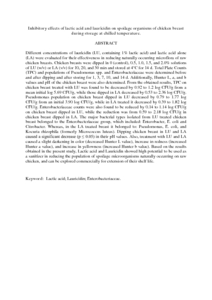Citation
Anang, D.M. and Rusul, G. and Ling , Foo Hooi and Bhat, Rajeev
(2010)
Inhibitory effects of lactic acid and lauricidin on spoilage organisms of chicken breast during storage at chilled temperature.
International Journal of Food Microbiology, 144 (1).
pp. 152-159.
ISSN 0168-1605
Abstract
Different concentrations of lauricidin (LU, containing 1% lactic acid) and lactic acid alone (LA) were evaluated for their effectiveness in reducing naturally occurring microflora of raw chicken breasts. Chicken breasts were dipped in 0 (control), 0.5, 1.0, 1.5, and 2.0% solutions of LU (w/v) or LA (v/v) for 10, 20, and 30 min and stored at 4°C for 14 d. Total Plate Counts (TPC) and populations of Pseudomonas spp. and Enterobacteriaceae were determined before and after dipping and after storing for 1, 3, 7, 10, and 14 d. Additionally, Hunter L, a, and b values and pH of the chicken breast were also determined. From the obtained results, TPC on chicken breast treated with LU was found to be decreased by 0.92 to 1.2 log CFU/g from a mean initial log 5.69 CFU/g, while those dipped in LA decreased by 0.53 to 2.36 log CFU/g. Pseudomonas population on chicken breast dipped in LU decreased by 0.79 to 1.77 log CFU/g from an initial 3.90 log CFU/g, while in LA treated it decreased by 0.39 to 1.82 log CFU/g. Enterobacteriaceae counts were also found to be reduced by 0.14 to 1.14 log CFU/g on chicken breast dipped in LU, while the reduction was from 0.59 to 2.18 log CFU/g in chicken breast dipped in LA. The major bacterial types isolated from LU treated chicken breast belonged to the Enterobacteriaceae group, which included: Enterobacter, E. coli and Citrobacter. Whereas, in the LA treated breast it belonged to: Pseudomonas, E. coli, and Kocuria rhizophila (formerly Micrococcus luteus). Dipping chicken breast in LU and LA caused a significant decrease (p ≤ 0.05) in their pH values. Also, treatment with LU and LA caused a slight darkening in color (decreased Hunter L value), increase in redness (increased Hunter a value), and increase in yellowness (increased Hunter b value). Based on the results obtained in the present study, Lactic acid and Lauricidin showed high potential to be used as a sanitizer in reducing the population of spoilage microorganisms naturally occurring on raw chicken, and can be explored commercially for extension of their shelf life.
Download File
![[img]](http://psasir.upm.edu.my/15236/1.hassmallThumbnailVersion/Inhibitory%20effects%20of%20lactic%20acid%20and%20lauricidin%20on%20spoilage%20organisms%20of%20chicken%20breast%20during%20storage%20at%20chilled%20temperature.pdf)  Preview |
|
PDF (Abstract)
Inhibitory effects of lactic acid and lauricidin on spoilage organisms of chicken breast during storage at chilled temperature.pdf
Download (189kB)
| Preview
|
|
Additional Metadata
Actions (login required)
 |
View Item |

